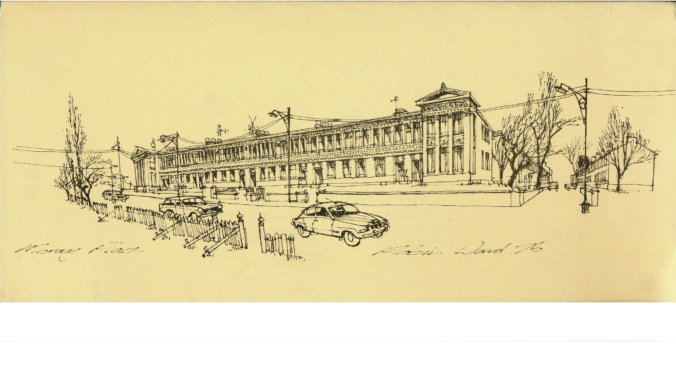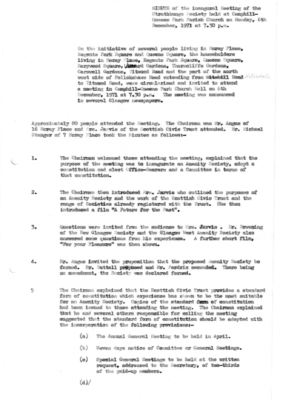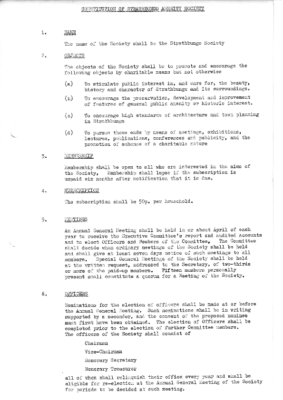Fifty years ago, Strathbungo was under threat of demolition as part of Glasgow’s then fascination with urban motorways. At the same time the idea of conservation was gaining ground, with the Civic Amenities Act of 1967 enabling new “Conservation Areas” to protect the historic environment. The tide was begining to turn.
In Strathbungo, the area was in chronic decline but the local community was buoyed by several developments. Several buildings had been listed, including 1-10 Moray Place in 1966, and many of the other sandstone terraces in 1970. Lord Esher published his 1971 report “Conservation in Glasgow”, recommending this “gem” of a neighbourhood should be protected . There was increasing recognition of Alexander Thomson’s work, with 1-10 Moray Place being described as “with little question the finest of all nineteenth-century terraces” (Henry-Russell Hitchcock).
A group of local residents set about doing something to save Strathbungo, and proposed an “Amenity Society for Moray Park and Regent’s Park”.
Their press release and proposal are reproduced below. They placed adverts were placed in the papers, and leafleted the residents of Strathbungo from Nithsdale Road to Titwood Road, inviting to a meeting on 6th December 1971 at Camphill Queen’s Park Church (now the Baptist Church).
The first meeting
Approximately eighty people turned up, and the meeting was chaired by Bob Angus of 16 Moray Place. Mrs Jarvis, representing the Scottish Civic Trust, explained the nature of Amenity Societies and Conservation Areas, and then introduced Peter Bradford’s BAFTA nominated film “A Future for the Past” . Sadly I cannot locate a copy.
She followed this with Derek Phillips’ animated film, For your Pleasure. This is still available, and well worth a watch. Its message resonates today, though there is little pleasure to be had in it.
The society was then created, and the new constitution introduced. The society name was to be “The Regents Park and Moray Park Society”. The name is a little unusual. Regents Park was the original name for the development we now call Strathbungo, but it fell out of favour mid 20th century, if it ever caught on at all. Moray Park, on the other hand; I think they just made up. [Editor’s note, Oct 2023: I was so wrong!]
Controversy! What’s in a name?
Dr Browning then spoke. He felt the name and area was too restrictive, and the society should take on a wider remit. The chair explained that they had considered including Crosshill, which Lord Esher had also recommended for conservation, but had decided to restrict their activities to Strathbungo initially, with the intention to expand once the society was better established.
Mr Stanger and Dr Nuttall then proposed accepting the constitution and the name. At that point, Robin Haddow, a young architect living on Moray Place, stood up and countered that “The Strathbungo Society” would be a much better name. This was therefore put to a vote, the chair was defeated, and at that moment The Strathbungo Society was born. I think we have a lot to thank Mr Haddow for, personally.
The first committee was elected, including Mr Woods (Chair), Mr Penny (Vice Chair), Mr Stanger (Secretary), Mr Perdrix (Treasurer), Mr Angus, Mr Yates, Mrs Larty, Dr Nuttall, Mr Haddow, Mr Russell, Mrs Lawson & Miss Mendelssohn (committee members).
And finally, membership was set at 50p.
The minutes of that first meeting and the first constitution of the society are reproduced below.
References
{3557955:RK3CPA7U};{3557955:4IAYZPGQ}
vancouver
asc
0
3077
%7B%22status%22%3A%22success%22%2C%22updateneeded%22%3Afalse%2C%22instance%22%3A%22zotpress-15f7c5820fb6a8064b9b2621c5545416%22%2C%22meta%22%3A%7B%22request_last%22%3A0%2C%22request_next%22%3A0%2C%22used_cache%22%3Atrue%7D%2C%22data%22%3A%5B%7B%22key%22%3A%224IAYZPGQ%22%2C%22library%22%3A%7B%22id%22%3A3557955%7D%2C%22meta%22%3A%7B%22parsedDate%22%3A%221971%22%2C%22numChildren%22%3A1%7D%2C%22bib%22%3A%22%3Cdiv%20class%3D%5C%22csl-bib-body%5C%22%20style%3D%5C%22line-height%3A%201.35%3B%20%5C%22%3E%5Cn%20%20%3Cdiv%20class%3D%5C%22csl-entry%5C%22%20style%3D%5C%22clear%3A%20left%3B%20%5C%22%3E%5Cn%20%20%20%20%3Cdiv%20class%3D%5C%22csl-left-margin%5C%22%20style%3D%5C%22float%3A%20left%3B%20padding-right%3A%200.5em%3B%20text-align%3A%20right%3B%20width%3A%201em%3B%5C%22%3E1.%3C%5C%2Fdiv%3E%3Cdiv%20class%3D%5C%22csl-right-inline%5C%22%20style%3D%5C%22margin%3A%200%20.4em%200%201.5em%3B%5C%22%3EBFI%20%5BInternet%5D.%201971%20%5Bcited%202021%20Sep%2023%5D.%20A%20Future%20for%20the%20Past.%20Available%20from%3A%20%3Ca%20href%3D%27https%3A%5C%2F%5C%2Fwww2.bfi.org.uk%5C%2Ffilms-tv-people%5C%2F4ce2b71ca9e84%27%3Ehttps%3A%5C%2F%5C%2Fwww2.bfi.org.uk%5C%2Ffilms-tv-people%5C%2F4ce2b71ca9e84%3C%5C%2Fa%3E%3C%5C%2Fdiv%3E%5Cn%20%20%3C%5C%2Fdiv%3E%5Cn%3C%5C%2Fdiv%3E%22%2C%22data%22%3A%7B%22itemType%22%3A%22webpage%22%2C%22title%22%3A%22A%20Future%20for%20the%20Past%22%2C%22creators%22%3A%5B%5D%2C%22abstractNote%22%3A%22%22%2C%22date%22%3A%221971%22%2C%22url%22%3A%22https%3A%5C%2F%5C%2Fwww2.bfi.org.uk%5C%2Ffilms-tv-people%5C%2F4ce2b71ca9e84%22%2C%22language%22%3A%22en%22%2C%22collections%22%3A%5B%22CAR6MXPM%22%5D%2C%22dateModified%22%3A%222021-09-23T17%3A57%3A01Z%22%7D%7D%2C%7B%22key%22%3A%22RK3CPA7U%22%2C%22library%22%3A%7B%22id%22%3A3557955%7D%2C%22meta%22%3A%7B%22creatorSummary%22%3A%22Esher%20et%20al.%22%2C%22parsedDate%22%3A%221971%22%2C%22numChildren%22%3A0%7D%2C%22bib%22%3A%22%3Cdiv%20class%3D%5C%22csl-bib-body%5C%22%20style%3D%5C%22line-height%3A%201.35%3B%20%5C%22%3E%5Cn%20%20%3Cdiv%20class%3D%5C%22csl-entry%5C%22%20style%3D%5C%22clear%3A%20left%3B%20%5C%22%3E%5Cn%20%20%20%20%3Cdiv%20class%3D%5C%22csl-left-margin%5C%22%20style%3D%5C%22float%3A%20left%3B%20padding-right%3A%200.5em%3B%20text-align%3A%20right%3B%20width%3A%201em%3B%5C%22%3E1.%3C%5C%2Fdiv%3E%3Cdiv%20class%3D%5C%22csl-right-inline%5C%22%20style%3D%5C%22margin%3A%200%20.4em%200%201.5em%3B%5C%22%3EEsher%20L%2C%20Glasgow%20%28Scotland%29%2C%20Corporation.%20Conservation%20in%20Glasgow%3A%20a%20preliminary%20report.%20Glasgow%3A%20Corporation%20of%20Glasgow%3B%201971.%3C%5C%2Fdiv%3E%5Cn%20%20%20%3C%5C%2Fdiv%3E%5Cn%3C%5C%2Fdiv%3E%22%2C%22data%22%3A%7B%22itemType%22%3A%22book%22%2C%22title%22%3A%22Conservation%20in%20Glasgow%3A%20a%20preliminary%20report%22%2C%22creators%22%3A%5B%7B%22creatorType%22%3A%22author%22%2C%22firstName%22%3A%22Lionel%22%2C%22lastName%22%3A%22Esher%22%7D%2C%7B%22creatorType%22%3A%22author%22%2C%22name%22%3A%22Glasgow%20%28Scotland%29%22%7D%2C%7B%22creatorType%22%3A%22author%22%2C%22name%22%3A%22Corporation%22%7D%5D%2C%22abstractNote%22%3A%22%22%2C%22date%22%3A%221971%22%2C%22language%22%3A%22English%22%2C%22ISBN%22%3A%22%22%2C%22url%22%3A%22%22%2C%22collections%22%3A%5B%22CAR6MXPM%22%5D%2C%22dateModified%22%3A%222021-09-23T17%3A44%3A45Z%22%7D%7D%5D%7D
1.
Esher L, Glasgow (Scotland), Corporation. Conservation in Glasgow: a preliminary report. Glasgow: Corporation of Glasgow; 1971.
Like this:
Like Loading...






September 25, 2021 at 9:20 pm
Another fascinating post. I think Strathbungo has a lot to thank the the people for who formed the Society in the early 1970s. It certainly would not look as it does today without their efforts and those of some of the current members.
October 6, 2021 at 8:08 pm
Thanks to Emily Sherriff at Scottish Civic Trust; she has tracked down the film “A Future for the Past”. The Trust sent it to the Scottish Screen Archive in 2009, and the National Library of Scotland have now digitised it. I have seen a copy but they are tracking down the relevant permissions before it can be released publically. Its fascinating, and just as relevant today; we are having the same old arguments 50 years on.